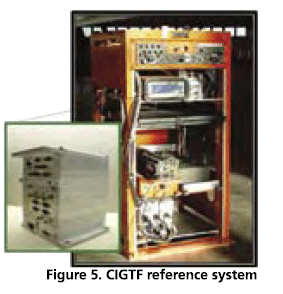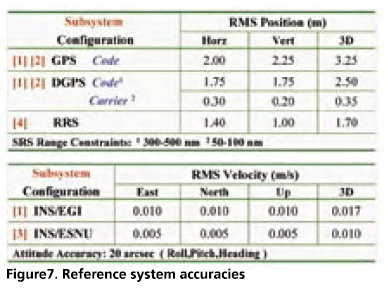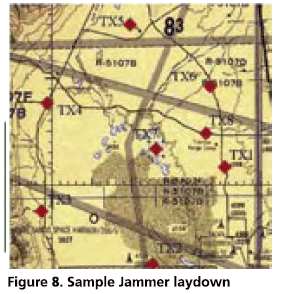| GNSS | |
JAMFEST, A cost effective solution to GPS vulnerability testing
Event conductJAMFEST testing began on 24 May 04 at 2000 MST and spanned 5 days. A total of 12 military organizations, DoD contractors, and civil agencies participated, all with very different goals and objectives. During the test week, 746 TS engineers conducted GPS jamming operations from 2000 to 0400 hours on each test day, and characterized the jamming field with ground and aviation monitoring equipment. Additionally, the 746 TS deconflicted all customer flight and ground operations and provided on-site technical experts to help resolve customer difficulties and ensure each objective was met. In some cases, this required significant instrumentation and analysis support. On each test day, two types of scenarios were offered: (1) Operationally realistic and (2) Experimental scenarios. Operationally realistic scenarios included threat laydowns consisting of one, four, and seven jammers broadcasting on L1 and L2 frequencies and using a variety of waveforms and power levels. Experimental scenarios, on the other hand, were useful for research and development efforts requiring high jamming levels capable of stressing robust anti-jam electronics. These scenarios were achieved by using seven close-proximity jammers focused in the same direction. Most JAMFEST participants utilized their own test beds and recorded their own receiver data and reference information. These participants either mounted their equipment in rental vehicles, government vehicles and aircraft or walked through the jamming environments. In other cases, the 746th TS provided support to participants who could not supply their own test beds, data collection systems, or reference data. In this situation, customer assets were mounted into the 746 TS land navigation vehicles. Customer assets were connected to FRPAs, CRPAs or prototype antennas, depending on the customer’s desires and asset availability. The jamming scenarios were carefully developed to maximize efficiency and meet everyone’s goals. A total of 59 jamming scenarios with different threat laydowns were executed during the test week. Jammer placement was carefully planned to maximize the number and variety of scenarios offered while minimizing relocation and set-up time. Figure 8 depicts three sample jammer placement scenarios. Utilizing a configuration similar to the one depicted, permitted the execution of one jammer, three jammer and seven jammer scenarios without relocating any of the jammers. This offered the most scenario flexibility while limiting the number personnel required to operate the jammers at these locations. For example, in a one jammer scenario, only the jammer at TX 8 may be used or in a three jammer scenario, the jammers at TX 6, TX 7 and TX 1 may be used. Lastly, in a seven jammer scenario the jammers at TX 1, TX 2, TX 3, TX 4, TX 5, TX 6, and TX 8 may be used. Typically, when these jammers were turned on, vehicles would drive down the corresponding range road, park at a predesignated location or fly though the jamming field. While most participants drove or flew during testing, other participants tested hand-held receivers and walked near the jamming field. During testing, the jammer configuration alternated between operationally realistic and experimental scenarios. All scenarios utilized a variety of waveforms at low, medium, high, and ramped power levels. The specific waveforms broadcast included Bi-Phase Shift Key, Broadband, Partial Band, Continuous Wave and Swept Continuous Wave, and Pulsed Continuous Wave on both L1 and L2 frequencies. Another jammer laydown used, involved placing multiple jammers along a predesignated range road all pointed in the same direction. Participants drove into and out of the field to test their equipment in a concentrated GPS jamming environment. Regardless of the means or scenarios used, the participants successfully met their objectives. Following each test day, 746 TS personnel checked ground jammer logs and collected reference data for accuracy and proper format and provided this information to each participant in the form of a data package. The purpose of the data package was to accurately document the event, cite any necessary deviation(s) from the test plan, detail exact scenarios as they are transmitted, and provide reference data that describes the signals received. Information in the data package was sufficient for each participant to evaluate their own data and generate defensible conclusions. SummaryJAMFEST serves as an affordable avenue to identify system limitations in a GPS jamming environment so that system designers and users can begin to identify and mitigate vulnerabilities in their specific applications. This is particularly valuable information to civil users who otherwise would not have access to such vulnerability scenarios. After participating in JAMFEST customers are better armed with realistic vulnerability data, to better understand their system limitations, work to mitigate these effects, and apply backup systems or procedures as appropriate. In addition to civil GPS users, JAMFEST also benefited operational military units who are likely to experience GPS jamming during operational conflicts but may not have actually experienced the effects of jamming during training maneuvers. Training in such electronic warfare environments raises vulnerability awareness and affords the opportunity to devise, implement, and practice countermeasures. AcknowledgementsThe authors would like to acknowledge the support of the GPS Joint Program Office, White Sands Missile Range, and the 46th Test Group. References1. NAVSTAR GPS System Protection Guide, GPS JPO, LAAFB, CA; 13 Jun 97. 2. 46 TGI 99-1, Safety Review Process; 01 Jun 01. 3. 46 TGI 99-101, Test Management; 30 Aug 01. 4. AFI 10-1101, Operations Security; 31 May 01 (including AAC Sup 1; 08 Apr 99 vice 31 Mar 95). 5. AFI 35-205, Air Force Security and Policy Review Program; 02 Nov 95 (Rev. 17 Jan 97). 6. AFI 91-202, The US Air Force Mishap Prevention Program; 01 Aug 98. 7. MIL-STD-882D, Standard Practice for System Safety; 10 Feb 00. |
||||||||||||||||||||||||||
|
||||||||||||||||||||||||||
|
Pages: 1 2

















 (No Ratings Yet)
(No Ratings Yet)




